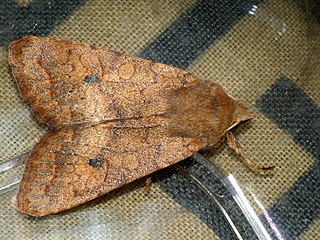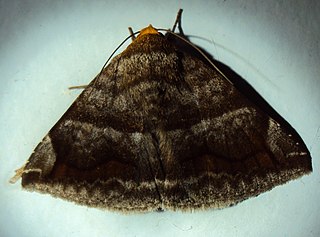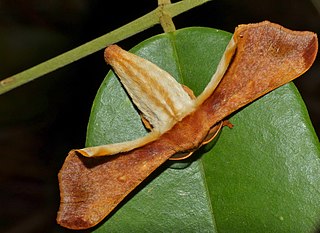
Agrochola circellaris, or The Brick, is a species of moth of the family Noctuidae. The species was first described by Johann Siegfried Hufnagel in 1766. It is distributed throughout most of Europe, Asia Minor and Armenia.

The angle shades is a moth of the family Noctuidae. The species was first described by Carl Linnaeus in his 1758 10th edition of Systema Naturae. It is distributed throughout Europe as far east as the Urals and also in the Azores, in Algeria, and in Asia Minor, Armenia, and Syria. It is strongly migratory.

Apamea monoglypha, the dark arches, is a moth of the family Noctuidae. The species was first described by Johann Siegfried Hufnagel in 1766. It is a common, sometimes abundant, European species. It is found in most of Europe except northernmost Fennoscandia and the southern parts of the Iberian Peninsula and Greece. The species is also found in Anatolia, Turkestan, Western Asia and Central Asia, Siberia and Mongolia. In the Alps it is found up to heights of 2,500 meters. The smaller subspecies sardoa is found on Sardinia and Corsica.

Apamea remissa, the dusky brocade, is a species of moth of the family Noctuidae. It is distributed throughout Europe and Turkey, ranging across the Palearctic realm to Siberia, Manchuria and Japan. It has also been reported from Alaska.

Allophyes oxyacanthae, the green-brindled crescent, is a moth of the family Noctuidae. The species was first described by Carl Linnaeus in his landmark 1758 10th edition of Systema Naturae. It is found in Europe.

Catocala nymphagoga, the oak yellow underwing, is a moth of the family Erebidae. It is found in Southern Europe, from Bulgaria up to the Iberian Peninsula and sometimes further north as a migrant. It is also found in North Africa and Asia Minor.

Grammodes stolida, the geometrician, is a moth of the family Erebidae. The species was first described by Johan Christian Fabricius in 1775. It is found in Africa, southern Europe, most of Asia and Australia. It migrates to central and northern Europe as far north as England, Denmark and Finland.

Thyas coronata is a species of moth of the family Erebidae first described by Johan Christian Fabricius in 1775. It is found from the Indo-Australian tropics of southern China, Taiwan, Japan, Nepal, India, Sri Lanka to Micronesia and the Society Islands.

Buzara onelia is a moth of the family Erebidae. It is found from the Indian subregion to Sri Lanka, Myanmar, Sundaland, the Philippines and Japan.

Buzara umbrosa is a moth of the family Erebidae. It is found in China, India and Sri Lanka.

Agrochola litura, the brown-spot pinion, is a moth of the family Noctuidae. The species was first described by Carl Linnaeus in 1761. It is found in Europe and the Middle East. It is possibly also present in North Africa, but this is unclear because similar looking species Agrochola meridionalis is found there.

Agrochola helvola, the flounced chestnut, is a moth of the family Noctuidae. It was first described by Carl Linnaeus in his landmark 1758 10th edition of Systema Naturae. The species is found in most of Europe, north to Scotland and Fennoscandia up to the Arctic Circle, south to Spain, Sicily, Greece further east to the Middle East, Armenia, Asia Minor, western Turkestan and central Asia up to central Siberia.

Fascellina chromataria is a moth in the family Geometridae described by Francis Walker in 1860. It is found in Korea, Japan, Taiwan, China, India, Bhutan and Sri Lanka.
Cibyra brunnea is a species of moth of the family Hepialidae. It was described by William Schaus in 1901 and is known from Venezuela and Peru.
Cibyra dorita is a species of moth of the family Hepialidae. It was described by William Schaus in 1901 and is known from Brazil.
Druceiella basirubra is a species of moth of the family Hepialidae. It was described by William Schaus in 1901 and is known from Bolivia and Peru.
Palpifer taprobanus is a moth of the family Hepialidae. It was described by Frederic Moore in 1887 and is found in Sri Lanka.

Mesoligia literosa, the rosy minor, is a moth of the family Noctuidae. The species was first described by Adrian Hardy Haworth in 1809. It is found throughout Europe, North Africa and western Asia. and east across the Palearctic to Siberia.

Gunda ochracea is a species of moth in the family Bombycidae. It was described by Francis Walker in 1862. It is found in the Indian subregion and from South-east Asia to Sumatra, Borneo and the Philippines. The habitat consists of various lowland forest types.
Oreta subvinosa is a moth in the family Drepanidae. It was described by William Warren in 1903. It is found in New Guinea, where it is known from Papua.













